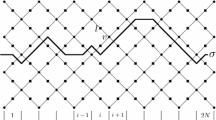Abstract
We give a new argument supporting a gravitational role in quantum collapse. It is demonstrated that the discreteness of space-time, which results from the proper combination of quantum theory and general relativity, may inevitably result in the dynamical collapse of the wave function. Moreover, the minimum size of discrete space-time yields a plausible collapse criterion consistent with experiments. By assuming that the source to collapse the wave function is the inherent random motion of particles described by the wave function, we further propose a concrete model of wavefunction collapse in the discrete space-time. It is shown that the model is consistent with the existing experiments and macroscopic experiences.
Similar content being viewed by others
References
Adler, S. L. (2001). preprint quant-ph/0109029.
Adler, S. L., Brody, D. C., Brun, T. A., and Hughston, L. P. (2001). Journal of Physics A: Mathematical and General 34, 8795.
Adler, R. J. and Santiago, D. I. (1999). Modern Physics Letters A 14, 1371
Amelino-Camelia, G. (2000). Nature 408, 661
Bell, J. S. (1993). In Davis, P. and Brown, J. (eds.), The Ghost in the Atom. Cambridge University Press, Cambridge.
Berg, B. A. (1996). preprint hep-ph/9609232.
Bunge, M. (1973). Philosophy of Physics. Reidel, Dordrecht.
Christian, J. (2001). In Callender, C. and Huggett, N. (eds.), Physics Meets Philosophy at the Planck scale. Cambridge University Press, Cambridge.
Cova, S., Ghioni, M., Lacaita, A., Samori, C., and Zappa, F. (1996). Applied Optics 35, 1956.
Diosi, L. (1989). Physical Review A 404, 1165.
Eidelman, S., et al. (2004). (Particle Data Group). Physics Letters B 592, 1.
Einstein, A. (1936). Journal of the Franklin Institute 221, 378.
Feynman, R. (1995). In Hatfield, B. (ed.), Feynman Lectures on Gravitation, Reading, Massachusetts, Addison-Wesley.
Fivel, D. I. (1997a). Physical Review A 56, 146.
Fivel, D. I. (1997b). preprint quant-ph/9710042.
Garay, L. J. (1995). International Journal of Modern Physics A 10, 145.
Ghirardi, G. C., Pearle, P., and Rimini, A. (1990). Physical Review A 42, 78.
Ghirardi, G. C., Rimini, A., and Weber, T. (1986). Physical Review D 34, 470.
Heisenberg, W. (1957). Reviews of Modern Physics 29, 269.
Hughston, L. P. (1996). Proceedings of the Royal Soceity, London A 452, 953.
Pearle, P. (1989). Physical Review A 39, 2277.
Pearle, P. (1999). In Petruccione, F. and Breuer, H. P. (eds.), Open Systems and Measurement in Relativistic Quantum Theory. Springer Verlag, New York.
Pearle, P. (2004). Physical Review A 69, 42106.
Percival, I. C. (1994). Proceedings of the Royal Soceity, London A 447, 189.
Penrose, R. (1996). General Relativity and Gravitation 28, 581.
Polchinski, J. (1998). String Theory, Cambridge University Press, Cambridge.
Redhead, P. A. (1996). In Rigden, J. S. (ed.), Macmillan Encyclopedia of Physics, vol. IV, p.1657. Simon & Schuster Macmillan, New York.
Rovelli, C. and Smolin, L. (1995). Nuclear Physics B 442, 593.
Salecker, H. and Wigner, E. P. (1958). Physical Review 109, 571.
Shan, G. (2000). Quantum Motion and Superluminal Communication, Chinese BT Publishing House, Beijing.
Shan, G. (2003). Quantum, Tsinghua University Press, Beijing.
Shimony, A. (1993). Search for a Naturalistic World View, vol. II. Cambridge University Press, Cambridge.
Smolin, L. (2001). Three Roads to Quantum Gravity, Weidenfeld and Nicolson and Basic Books, London and New York.
Snyder, H. S. (1947). Physical Review 71, 38.
von Neumann, J. (1955). Mathematical Foundations of Quantum Mechanics, Princeton University Press, Princeton.
Author information
Authors and Affiliations
Corresponding author
Additional information
PACS numbers: 0365B 0460
Rights and permissions
About this article
Cite this article
Shan, G. A Model of Wavefunction Collapse in Discrete Space-Time. Int J Theor Phys 45, 1943–1957 (2006). https://doi.org/10.1007/s10773-006-9163-7
Published:
Issue Date:
DOI: https://doi.org/10.1007/s10773-006-9163-7



